What is Substack, you ask?
Substack is a major platform in the world of online publishing. Traditionally, writers, journalists, and essayists used the platform. But, as with all of the internet, Substack has evolved.
Now, businesses are using it as a direct line to their audiences. It connects the immediacy of social media with the depth and ownership of email marketing. And it might just be the missing piece in your social media marketing plan.
And it can be a pretty lucrative platform. The Wall Street Journal says the top 10 Substack creators collectively bring in more than $40 million a year.
Read on to learn everything you need to know about Substack, and whether or not it’s the right choice for your brand.
Key Takeaways
- Substack is more than just a newsletter tool. It’s a full publishing platform that combines blogging, email, and subscriptions — giving creators and brands a direct line to their audiences without relying on algorithms.
- It’s built for connection, not clicks. Substack blends the personal feel of email with the reach of online publishing, helping brands share long-form, authentic stories that build trust.
- Businesses are getting on board. From fashion labels to media brands, companies are using Substack to publish insights, and grow communities.
- Consistency and authenticity drives success. Whether you’re a creator or a brand, Substack rewards honest, useful content shared regularly.
What is Substack?
Substack is a media platform that serves as a publishing hub for content, an email newsletter delivery system, and a means for creators to monetize their content through subscriptions.
Substack enables writers and creators to distribute subscription-based content directly to their audiences. The type of content can be:
- Articles,
- essays,
- podcasts and other audio, and
- videos.
Substack is unique in its functionality. It’s a 3-part model involving publishing, email, and subscription:
- Publishing platform: Creators can easily write, create, and publish content that lives on Substack’s public-facing website. Readers can browse free content much like any blog or online magazine.
- Email delivery system: Unlike traditional blogs, every new post can also be delivered directly to your email list. This bridges the gap between open web publishing and direct inbox communication. Newsletter subscribers never miss an update, and writers have a built-in distribution system.
- Subscription features: Substack lets creators offer free or paid subscriptions. Paying subscribers can unlock premium content while free subscribers only get access to public posts. Substack handles payments, subscriber management, and analytics, so creators can focus on their content. The paywall is optional, of course.
Substack originally started out as a simple newsletter platform loved by bloggers. But it’s evolved into something useful for most marketers, brands, and influencers.
Now, it’s one of the new social media platforms professionals are flocking to.
Comment
byu/CrochetAndTrueCrime from discussion
inSubstack
Substack is different from traditional corporate blogs, newsletters, and in-app platforms because of its:
- Online platform with a direct-to-audience model without reliance on SEO, social media, or ads.
- Dedicated site for each newsletter publication, so content can be archived but accessible.
- Social features like Substack Notes and discussion threads for community interaction and recommendations.
- Ability to get revenue straight to creators from the audience with its subscription model.
Many corporate newsletters need marketing teams, design tools, and CRM systems. Substack blends all of this up into one streamlined platform.
For expert Substack advice, we spoke to Omobolaji Ajibare, the Chief Content Officer of TheSocialMediaOga. Ajibare has thousands of subscribers and uses Substack as one tool in her digital marketing strategy.
“I use Substack as an extension of my work as a Social Media Manager, Mentor, and Content Creator,” says Ajibare. “My newsletter, The Social Media Manager Bible, is where I break down strategies, case studies, tools, and lessons that don’t always fit neatly into Instagram carousels or YouTube videos.”
How does Substack work for businesses?
Substack works for businesses in the same way it works for individuals, by acting as both a publishing platform and a direct channel to customers.
As a business, you get:
- Direct publishing to email inboxes.
- Free and paid subscription models.
- Built-in community engagement, like comments and recommendations.
In fact, more and more businesses are realizing the potential of Substack. Fashion brand Tory Burch, for example, runs a Substack called What should I wear?
The Substack feed is all about giving readers a look behind the scenes of the fashion world.
Source: What Should I Wear
Why businesses and enterprises use Substack
Instead of relying on algorithms or third-party platforms, businesses own their subscriber list hosted on Substack. They’re able to send content directly to them.
“Unlike Instagram or TikTok, where I’m at the mercy of algorithms, Substack puts me directly into someone’s inbox,” says Ajibare. “That intimacy matters when you’re teaching, because you’re not just chasing views — you’re nurturing a dedicated community of learners.”
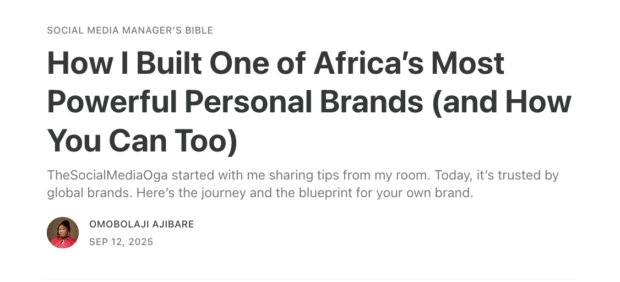
Source: The Social Media Manager’s Bible
The platform makes it simple to share updates, insights, or long-form content in a professional, branded way. Plus, it provides two-way engagement through comments and community features. Brands can use Substack to build trust and transparency.
Key features of Substack for businesses
For businesses, Substack is “a chance to move away from broadcast marketing and toward thought leadership,” says Ajibare. One key feature of Substack is the trust readers have in authors. This gives businesses the opportunity to connect more closely with their audience.
“Instead of just saying ‘Here’s our product,’ brands can say ‘Here’s how we think about the industry, here’s what we’re learning, here’s a case study of how we solved a problem.’” This transparency builds trust and positions brands as a go-to voice in their niche. And niche marketing is one of this year’s biggest social media trends.
Ajibare also mentions that the ability to create sections and series is a key feature for her brand.
“For example, I can run a series on analytics, then another on creator marketing, and readers can easily go back and binge everything. It’s like organizing my library of knowledge in public.”
Other key features of Substack for businesses include:
- Newsletter publishing with easy setup.
- Subscription models for audience segmentation.
- Millions of readers already in the Substack system with credit cards on file.
- Analytics and audience insights.
- Podcast and video hosting for multimedia storytelling.
- Recommendation features for discoverability.
- Substack Boost, which uses your data, expertise, and discounts to grow your audience.
- An SEO team that works to get publishers ranking in SERPs.
- Advanced SEO tools.
Who should use Substack inside a business?
Any role in a business that benefits from direct communication, storytelling, or building trust with an audience can use Substack. It’s not just for “marketing.” It’s a cross-functional tool that makes your business seem more like people, and less like a faceless brand.
“For individuals like me, the goal is often to build authority through sharing my own journey and lessons,” says Ajibare. “But the overlap is huge. Whether you’re a brand or an individual, Substack works when you stop thinking of it as content marketing and start thinking of it as community-building.”
Executives and leadership for thought leadership
Executives need a platform that feels personal and direct, not filtered through PR jargon. People want to hear from leadership.
Aleen Dreksler, the CEO of Betches, started the Substack Please Advise. Dreksler uses Substack to give out free business and life advice to her 1.9k followers. She shares long-form reflections on industry trends and leadership lessons in a relatable voice. This positions her as an accessible thought leader.
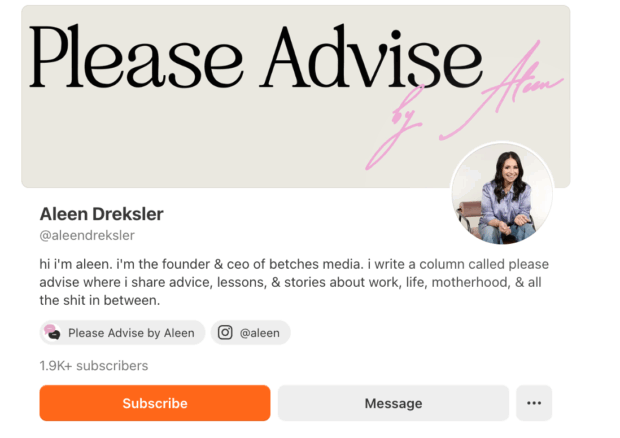
Source: Please Advise
Marketing teams for brand storytelling and campaigns
Marketing feeds off of stories, and Substack makes it easy to deliver narratives right to your audience. And you won’t need to pray that the social algorithms play nice.
You’re going to want to publish content that an audience actually wants to read.
Substack probably isn’t the place to toot your own brand horn for the sake of bragging about your products. Instead, give people an insider look into a recent campaign, spotlight the nitty-gritty of customer stories, or publish behind-the-scenes content that shows what it’s really all about.
HR or employer brand teams for recruitment and culture-building
Potential recruits want to know what it’s like to actually work at your company. Not just what the careers page says.
Use Substack to share:
- employee stories,
- culture spotlights
- transparent updates about initiatives like DEI or sustainability
Don’t use your platform to share only the most polished content, either. Give people an actual look behind the curtain.
Product teams for customer education and community support
Customers want more than product release notes. They want context and guidance.
Publish product updates, tutorials, and case studies. Use comments to create a feedback loop where customers can ask questions and share ideas.
Communications and PR teams for crisis transparency
In moments of high scrutiny, a direct, unfiltered channel builds credibility. You don’t need to have a dedicated PR Substack, but using your company’s general channel to speak to your audience during a crisis is a good idea.
Use Substack to address challenges, clarify the company’s stance, and provide updates directly to stakeholders without waiting for media gatekeepers.
R&D and innovation teams for thought experiments
Innovators need a sandbox to share early ideas and gather feedback. An R&D team can use Substack to publish research notes, gather feedback, perform trend analyses, or offer sneak peeks into the future of their industry. Early adopters in your subscriber base can act as a sounding board.
How much does Substack cost?
Publishing is always free, but Substack charges creators 10% of each transaction.
Similarly, Substack is always free for readers; they only pay for the subscriptions they sign up for.

Source: Substack
For creators, you can also expect to pay fees to Stripe for any credit card transactions made by your subscribers. Even if your subscribers choose to pay with other methods, like direct debit, you’ll still pay a Stripe fee. The amount depends on the country where you registered your account.
Hypothetically, let’s say you set your paid newsletter subscription at $10/month. Substack takes 10%, so $1.00 per subscriber. Stripe’s standard for U.S. cards is 2.9% + $0.30 per transaction, so 2.9% of $10 = $0.29, plus $0.30 flat fee. Your total Stripe fee = $0.59.
$10.00 – $1.00 (Substack) – $0.59 (Stripe) = $8.41 net subscription revenue per sign-up. If you have 1,000 subscribers, you’ll see $8,410/month.
That all being said, other payment methods (like iDEAL or SEPA) are different, and failed or disputed payments can carry extra costs.
How to start a Substack for your brand (step-by-step)
Before you start with Substack, you’ll want to define your content strategy. Are you interested in posting thought leadership, industry insights, or culture content?
Making a content creation strategy will give you a clear path forward on what you’re going to publish on Substack.
Once you’re ready, here’s the Substack step-by-step:
1. Sign up and create a publishing profile.
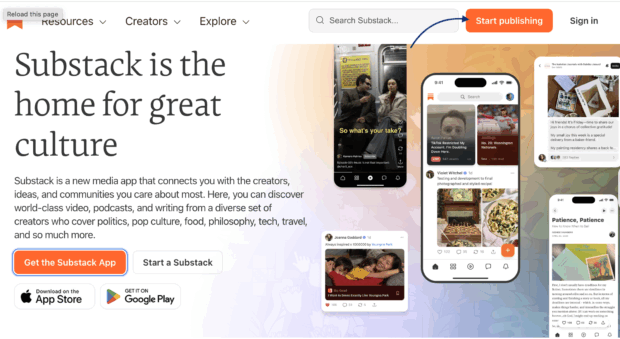
2. Sign up with your email, then choose a username.
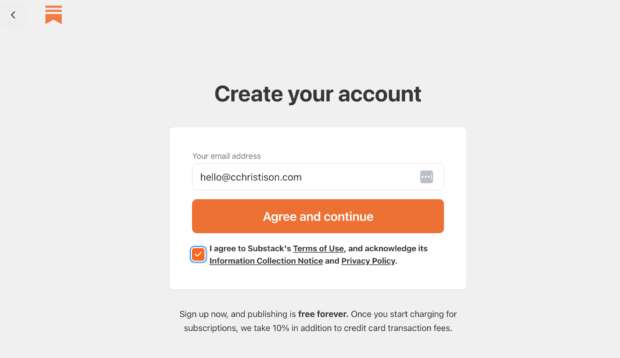
3. Upload any mailing lists you’ve got.
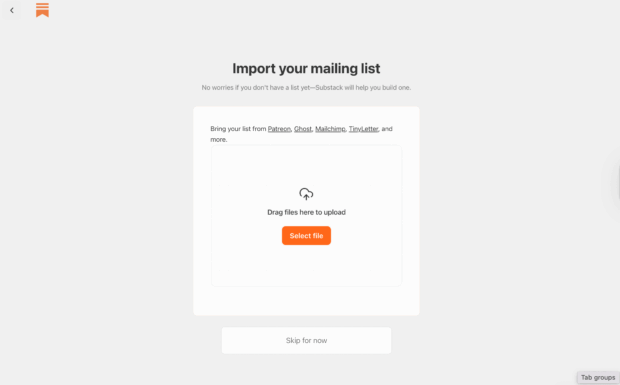
4. Add subscribers. If you have anyone you would like to invite to your Substack, now’s the time to add their emails.
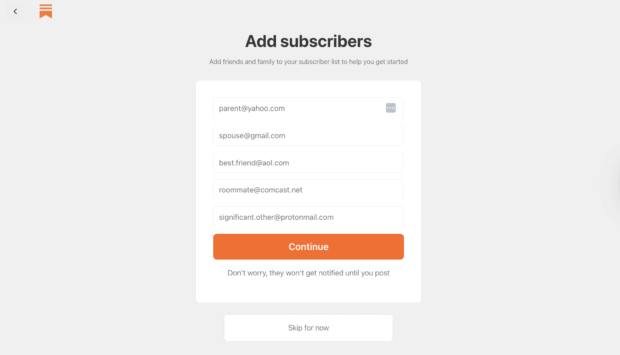
5. Add like-minded publishers to your recommendation list to grow your Substack ecosystem.
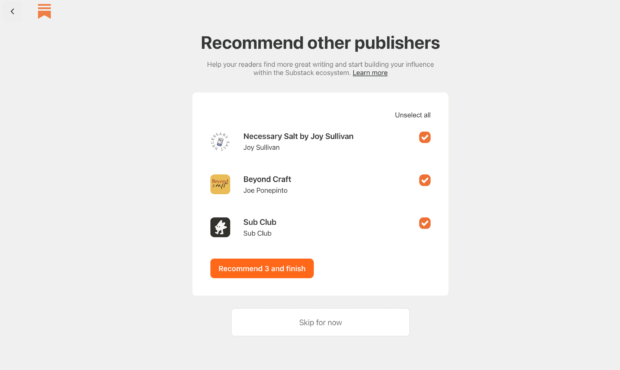
6. Click on Set up the basics and add your brand name, description, and logo.
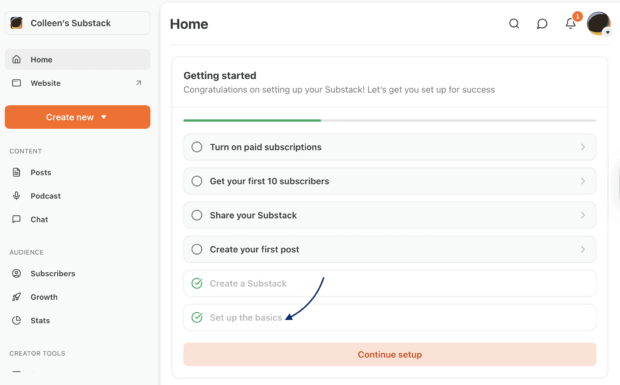
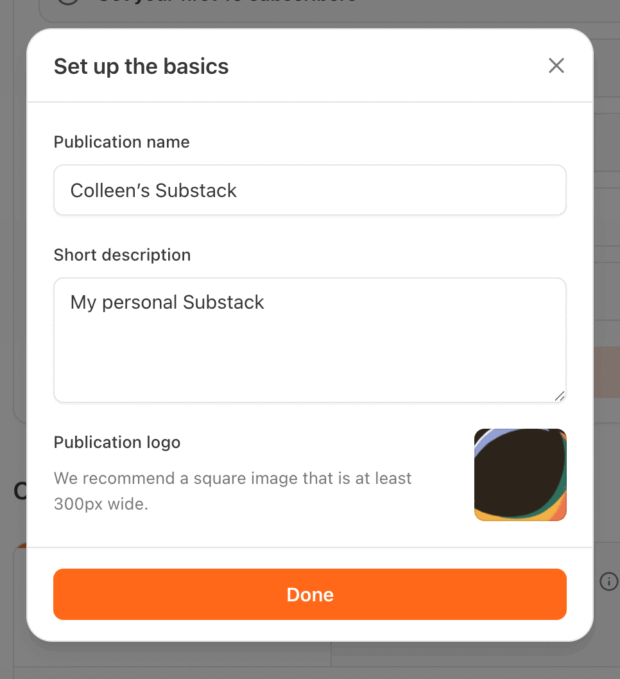
7. Head to your Settings (found on the left menu on the home page) and try to fill in as much information as you can.
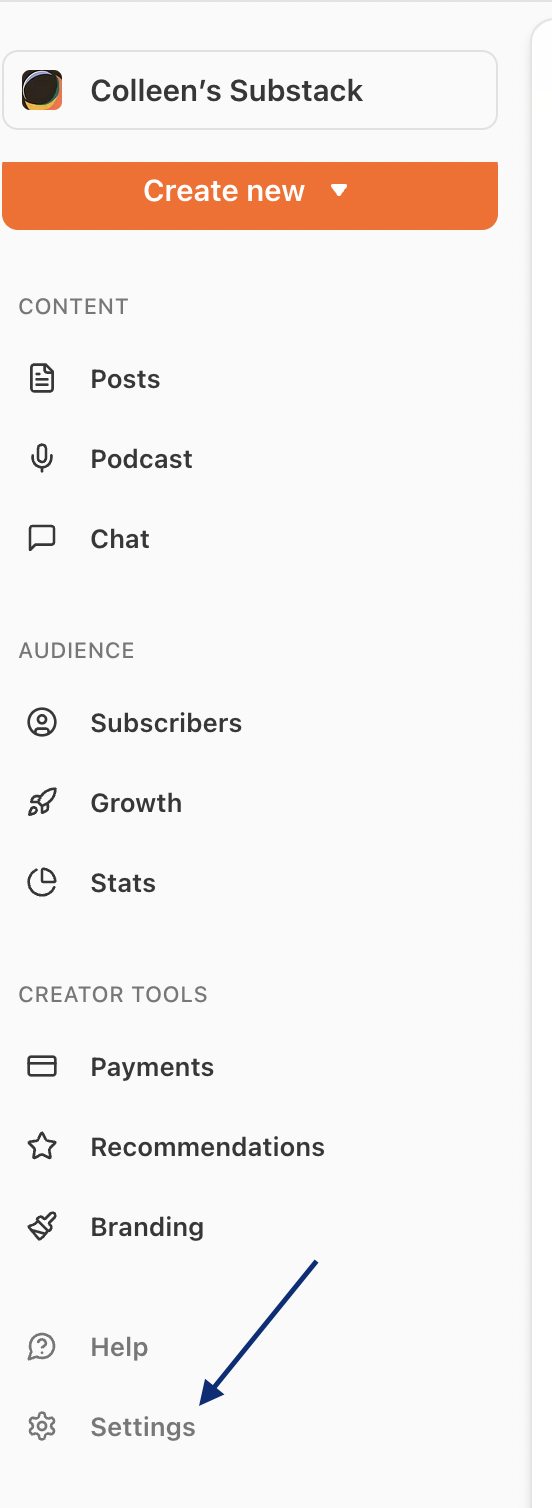
8. Within Settings on the left menu, you’ll find subheadings like ‘Appearance’ where you can tailor your Substack appearance to your brand. And under ‘Content’, you can customize your automated emails to reflect your brand voice and values.
9. Head back out to your dashboard. Further customize your Substack to reflect your brand colours, font, and other visual identity bits under Creator Settings → Branding on the left menu. You’ll also see the option for Homepage, which allows you to tailor your style and layout for your Substack homepage.
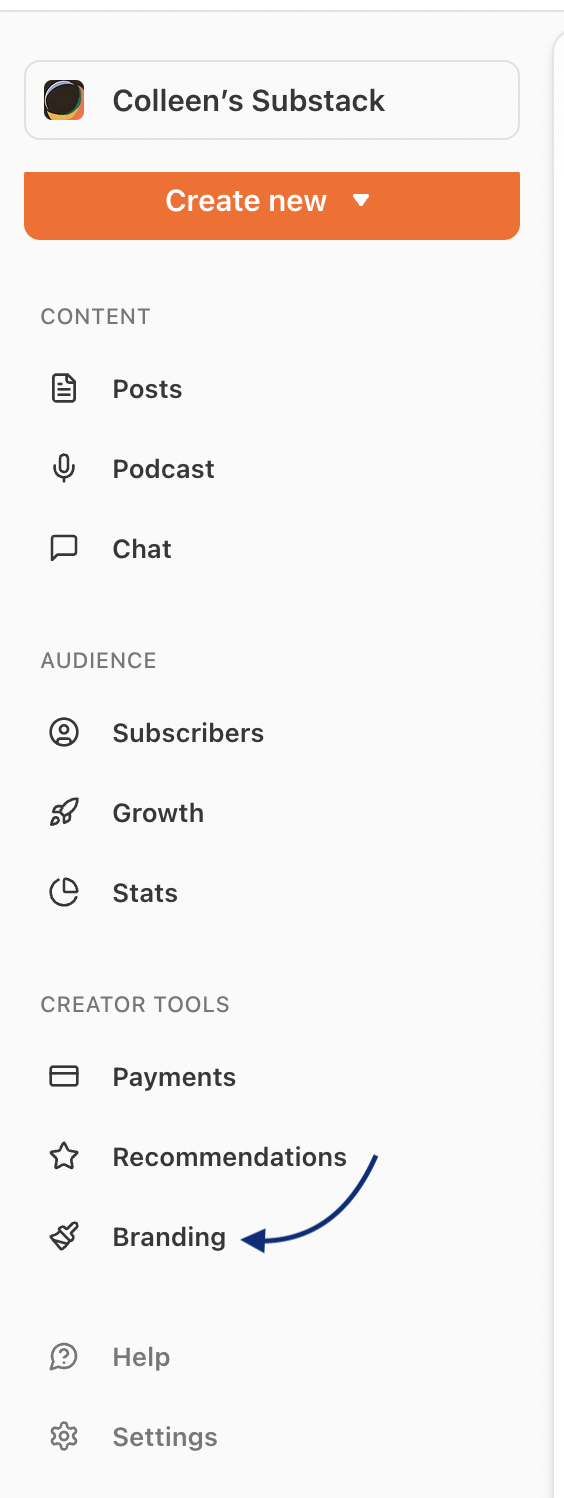
10. Back at your home dashboard, click on Payments (from the left menu, under Creator Tools). In this tab, you can set up your Stripe account so subscribers can give you money.
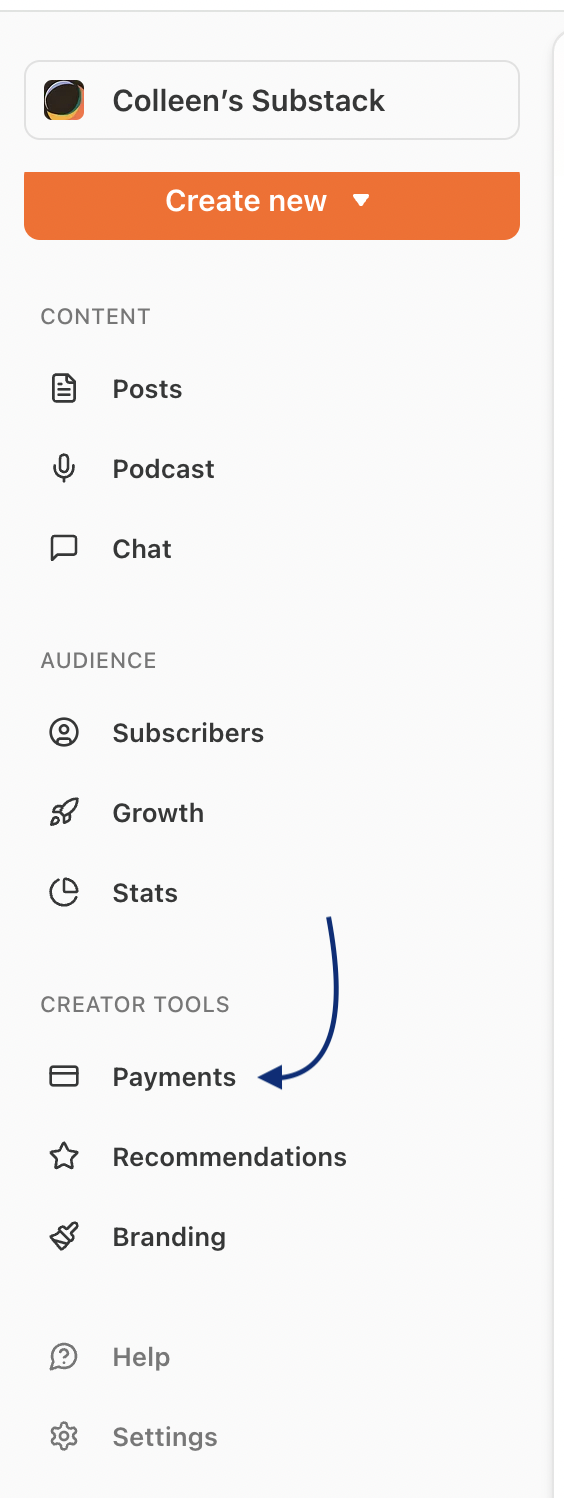
11. Then, it’s as simple as hitting that giant, orange Create new button and publishing your first post. Be sure to promote it on your social channels!
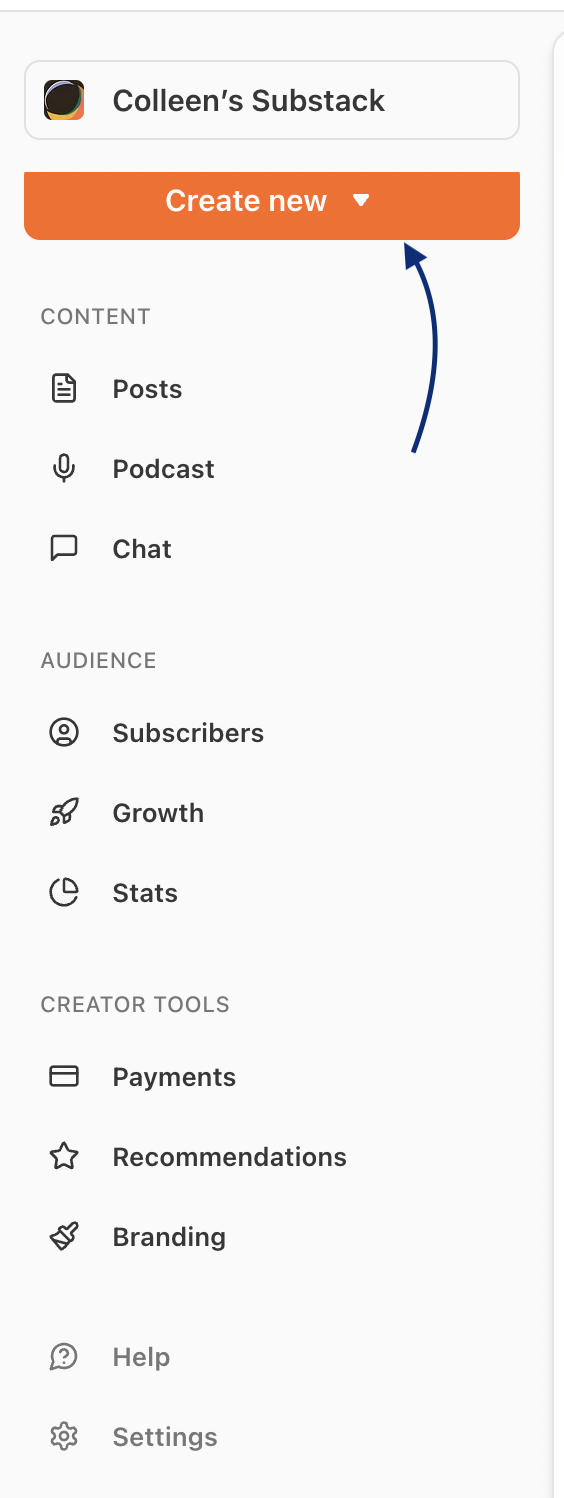
12. Then, the only thing that’s left to do is to track your analytics and refine your strategy over time.
How can businesses use Substack to generate value?
The Substack website is for “any business that wants to build depth, not just reach,” says Ajibare.
Shift from promotion to thought leadership
“Enterprise teams sometimes overlook the fact that people are tired of being marketed to all the time,” says Ajibare.
“Substack offers a chance to have conversations, share insights, and position your brand as a trusted guide rather than just a seller.”
Build direct relationships with your customers
Forget chasing engagement through social media algorithms. Substack delivers your content straight to subscribers’ inboxes, creating a direct, high-value connection with your most loyal audience.
Build trust through dialogue
Your newsletter can become a living hub for ideas, updates, and reflection. Use it to invite responses, start discussions, and cultivate an informed community around your brand values.
Lean into being unpolished
Whether you’re sharing campaign lessons or leadership reflections, authentic storytelling helps your brand stand out. “You don’t have to produce perfect essays,” says Ajibare.
Substack rewards honesty and depth — two things audiences rarely get from corporate blogs.
Pros and cons of Substack for businesses
| Pros | Cons |
| Easy to use with a low barrier (free) entry. | Limited customization compared to enterprise tools. |
| Built-in distribution capabilities with a direct relationship with your audience. | You’re paying fees on your subscriptions. |
| Supports multimedia and community engagement. | Discovery still depends, in part, on external promotion. |
| Millions of readers with credit cards on file already exist in-app, looking to subscribe to Substack newsletters. | Lack of email marketing features compared to some other apps. |
| Recommendation features allow for easy discoverability. | Content is not strictly moderated, so your branded content could show up beside unsavoury material. |
| Growth features designed to help you boost your audience numbers, like referral programs. | Basic analytics and reporting features. |
| Notifications keep users engaged. | Although you technically own your audience, it is still hosted on Substack, which could change its rules. |
| Substack app is easy to use and available on iOS and Android. | Not open-source (WordPress may be an alternative). |
7 Substack best practices for brands and businesses, according to the experts
1. Show up consistently
Many brands launch a newsletter with excitement, post twice, then vanish. And readers notice,” says Ajibare. “Substack requires you to treat your audience like a relationship. If you only show up when you need something, the trust breaks.”
Pick a cadence you can sustain and stick to it. Consistency signals reliability and builds long-term loyalty.
2. Get specific
Skip vague thought pieces. Focus on niche, actionable topics your audience can use right away. Think of detailed how-tos, case studies, or campaign breakdowns.
3. Repurpose what works elsewhere
Transform high-performing social posts, webinars, or internal insights into long-form newsletters. It’s a smart way to deepen your existing content without doubling your workload.
“A lot of creators feel overwhelmed by yet another platform,” says Ajibare. “But Substack doesn’t have to be extra work. You can take what’s already working for you on other platforms and expand it here.”
4. Avoid the sales trap
Your readers came for insights. Lead with useful stories and lessons. Sprinkle in promotion sparingly.
“Substack readers are not looking for ads disguised as newsletters,” says Ajibare. “They’re looking for insights, stories, and real value. If every post feels like a sales pitch, people unsubscribe. My advice is simple: give 80 percent value, 20 percent promotion.”
5. Define your voice early
“Substack works when you sound human. Don’t try to be overly formal or corporate,” says Ajibare. “Decide what your unique perspective is and build from there.”
Whether your tone is bold, conversational, or analytical, stay consistent. Readers will subscribe for your perspective, not your polish.
6. Play the long game
“Substack isn’t about instant virality,” says Ajibare. “It’s about compounding trust. Even if you only have 50 subscribers at the start, that’s 50 people who gave you direct access to their inbox.”
7. Don’t underestimate the power of structure
“Create series, themes, or recurring segments,” says Ajibare. “That makes your content easier to follow and gives people a reason to come back.”
FAQ: What is Substack?
What do people use Substack for?
People use Substack to publish and distribute content to an audience, either on a subscription model or for free.
Is Substack free to use?
Yes, Substack is free to use. You only pay when you either subscribe to a creator or have subscriptions coming in.
What is the downside of Substack?
Limited customization capabilities and a lack of email marketing features, subscription fees, lack of content moderation, and basic analytics and reporting features. If you’re looking for enterprise-level capabilities, you will find Substack to be pretty basic.
Can you read Substack for free?
Yes, Substack has a free, public platform for readers.
Can companies use Substack for marketing?
Absolutely, companies use Substack to humanize their marketing, build communities and audience bases, and share long-form content. Some use it to generate revenue through subscriptions.
How do businesses make money on Substack?
Businesses make money on Substack by using a subscription-based model.
What’s the difference between Substack and LinkedIn newsletters?
With Substack, you own your audience and can monetize your list directly. With LinkedIn, you’re posting on the platform to its audience and are dependent on the LinkedIn algorithm.
How do I start a Substack for my company?
By signing up for Substack and branding your page as your company. Then create and publish content consistently.
Save time managing your social media presence with Hootsuite. Publish and schedule posts, find relevant conversions, engage your audience, measure results, and more — all from one dashboard. Try it free today.







